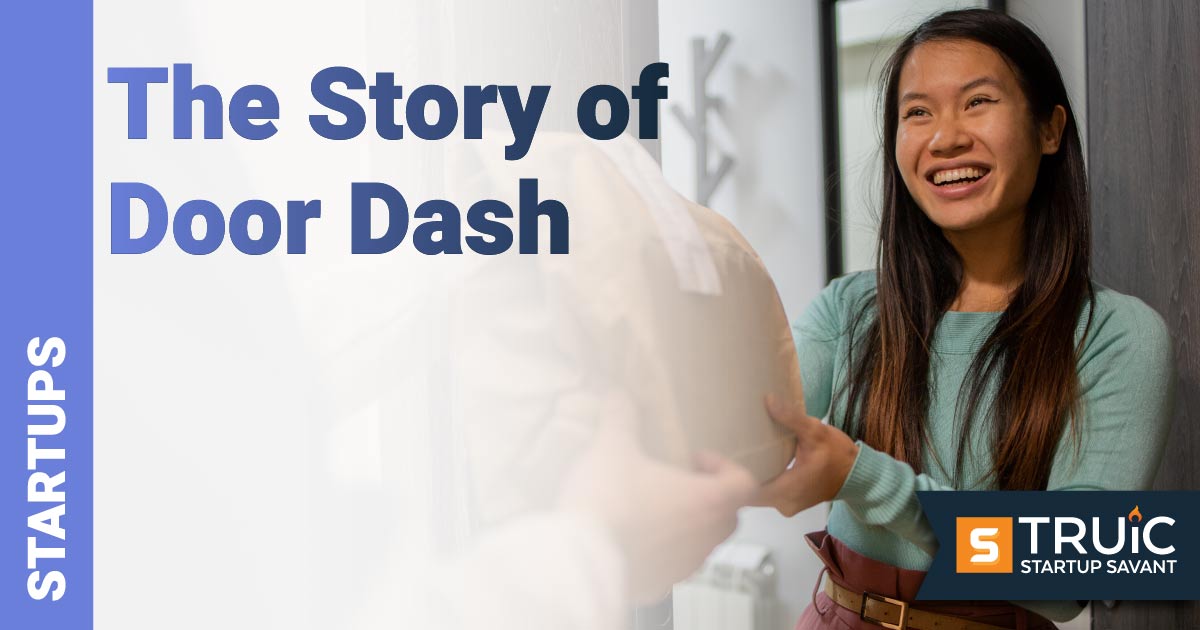How DoorDash Dominated the Food Delivery Sector

Last Updated: By Michaela Dale
When four students set out to create a mobile app for local delivery, they had no idea it would become the dominant food delivery service in the United States.
DoorDash is a wildly successful logistics startup whose success has surpassed major companies like GrubHub and Uber in various metrics, including 45% of all food deliveries in the US in 2020. But how did this student-founded company get started? This is the story behind DoorDash’s ingenious strategy and resilience that took the startup to the top.
DoorDash Overview and History
DoorDash is a logistics company that operates a digital food delivery platform. Founded in 2013 by Stanley Tang, Tony Xu, Andy Fang, and Evan Moore, DoorDash enables users to order food from local restaurants and have it delivered directly to their door.
Tang, Fang, Xu, and Moore originally set out to create a mobile app called Palo Alto Delivery for small businesses after attempting to troubleshoot an issue one local business owner was experiencing. The original mission, “build the local, on-demand FedEx.”
The startup was able to secure $120,000 in seed funding from Y Combinator in March of 2013 and another round in October of that year, totaling $2.4 million from Khosla Ventures as well as others. This would help grow the venture that would result in the wildly successful DoorDash platform.
Seven years after the company’s launch, in 2020, DoorDash went public, and three years later, the company boasted a staggering revenue of $8.15 billion with 34.38% growth year-over-year.
How Does DoorDash Make Money?
Users can place orders through the DoorDash website or mobile app, selecting from menus and paying electronically. The service relies on independent contractors, known as "Dashers," who use their own vehicles to pick up and deliver the orders.
DoorDash earns revenue primarily through a combination of delivery fees, commission fees, and subscription services. Customers usually pay a delivery fee on each order, which varies based on factors like distance and demand.
Additionally, DoorDash charges restaurants commission fees, which are a percentage of the total order value placed through its platform. This commission is a significant revenue stream, as it capitalizes on the sales of partnered restaurants.
DoorDash’s revenue streams don’t stop there, however. The service also offers a subscription service called DashPass, where customers pay a monthly fee to receive reduced service fees and free deliveries on orders over a certain amount. This subscription model provides a steady income stream and encourages customer loyalty and frequent use of the service.
DoorDash's competitive advantage over other food delivery services lies in its expansive network and technology-driven approach. It offers one of the largest selections of restaurants and is available in numerous markets, reaching a wide customer base. DoorDash has also invested heavily in advanced logistics and data analytics, optimizing delivery routes and times for efficiency. This tech-centric strategy enables a more reliable and faster service.
DoorDash Marketing Strategies
DoorDash leverages several digital marketing strategies, such as targeted ads on social media platforms like Facebook and Instagram, as well as search engine optimization (SEO). The company also frequently offers promotions and discounts to new and existing customers to build brand loyalty and attract new users.
One major marketing push for the company is its DashPass program. While this is a standout feature, it is also a brilliant tactic to gain a more loyal customer base and keep users on the platform to increase consistent usage. By offering discounts and perks available only to DashPass members, DoorDash has created a marketing strategy that continuously delivers.
The company has also historically taken on strategic partnerships such as the one with KFC in 2015 and Anheuser-Busch in 2016. As well as consistent technological advancements in robot delivery to faster, contactless delivery options.
What’s Next for DoorDash
DoorDash has become the most popular food delivery service in the US, and now they look to do the same in other countries and cities. The company looks to continue its global expansion, entering some new markets by way of acquisitions of competitors.
While its focus may appear to be on expansion overseas, the company is also expanding its New York presence with over 115,000 square feet of new office space and continuing to make impactful app updates in order to improve the experience of existing customers.
Above all, in an industry with fierce competition from companies like Uber and GrubHub, the chief priority for DoorDash is the continuation of their aggressive growth strategies to maintain their title as the dominant third-party delivery provider on the market.


